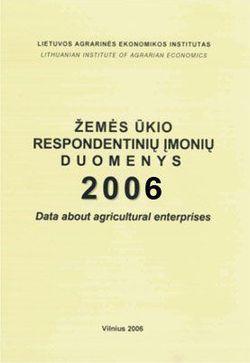
Statistical publications „Data about agricultural enterprises“ are published annually since 1996. The publication of 2007 is based on accountancy data of 2006 from 1300 family farms and 43 agricultural companies. Selected farms cover all districts, natural zones and reflect different farming conditions.
Lithuania must deliver data of 1000 farms to the EU Farm Accountancy Data Network (FADN). Lithuania is considered to be one FADN region, the threshold of the field of observation is 2 ESU (European Size Units). A sample farm represents 35 - 40 farms.
According to the Lithuanian legislation Lithuanian Institute of Agrarian Economics is assigned to be a Liaison Agency, Lithuanian Agricultural Advisory Service - Accountancy office.
Like in previous years, statistical results of family farms and agricultural companies are presented separately, as they are very different from both economic size and labour input. Some types of farming and economic size classes are aggregated. Averages of the previous year are also presented, what enables to compare farming results in the course of the last two years. Structure of the sample family farms and agricultural companies is revealed in the tables 4 and 5 respectively. Data of FSS 2005 and farm register served to calculate weighted averages for both types of farms and cover almost completely field of observation.
In general, year 2006 was not favorable for agriculture. Huge part of winter crops was lost due to nasty winter. Hot and dry summer badly influenced the crops too. Therefore, crop yields were significantly lower than normal, however, prices for different crops increased by 10 - 40 per cent. In average, total output crops decreased by 40 per cent. Livestock production was also influenced: farmers were not able to produce enough feedingstuffs, what led to decrease of livestock output. However, farmers received higher subsidies (including compensation for loss of production in 2006). As the result, Family Farm Income was 18 per cent lower compared to previous year. Notwithstanding, in family farms investments were higher by 3 per cent, debts - lower by 25 per cent, compared to 2005. However, in Agricultural Companies Farm Income were reduced more than twice due to significant increase of costs. Generally, the best results per 1 ESU were achieved in livestock farms, worst ones - in crop farms.
This publication contains 55 tables. Both family farms and agricultural companies are grouped by:
- economic size;
- type of farming;
- area;
- land quality point.
In addition family farms are grouped by:
- farmer’s age;
- counties;
- less favoured (LFA) and normal areas;
- organic farms.
Types of farming in family farms (row headings in the tables of family farms)
1. specialist cereals, oilseeds and protein crops (TF 13);
2. general field cropping (TF 14);
3. horticulture and permanent crops (TF 20, 34);
4. specialist dairying (TF 41);
5. mixed cropping (TF 60);
6. mixed livestock, mainly grazing livestock (TF 42, 43, 44, 71);
7. field crops-grazing livestock, combined (TF 81);
8. field crops and granivores, combined (TF 50, 72, 82).
Types of farming in agricultural companies (row headings in the tables of agricultural companies)
1. crops (TF 13, 14, 60);
2. horticulture and permanent crops (TF 20, 34);
3. field crops - granivores, combined (TF 50, 72, 82);
4. field crops-grazing livestock, combined (TF 81).
© Quoting requires reference to the source and website address.
